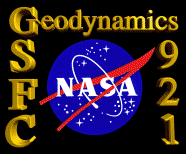

 ESA has picked its next Explorer mission, and it is one in which the GSFC Geodynamics Branch is strongly involved. SWARM, a magnetic field constellation mission, chosen over six other Earth Science missions by the Earth Observation Program Board, is scheduled for launch in 2009. This will complete a six-mission Decade of Geopotential Research begun with the 1999 launch of the Danish satellite Oersted and including launches of SAC-C (2000), CHAMP (2000), GRACE (2001) and GOCE (2006).
ESA has picked its next Explorer mission, and it is one in which the GSFC Geodynamics Branch is strongly involved. SWARM, a magnetic field constellation mission, chosen over six other Earth Science missions by the Earth Observation Program Board, is scheduled for launch in 2009. This will complete a six-mission Decade of Geopotential Research begun with the 1999 launch of the Danish satellite Oersted and including launches of SAC-C (2000), CHAMP (2000), GRACE (2001) and GOCE (2006).
The SWARM concept consists of a constellation of three satellites in two different polar orbits between 400 and 550 km altitude. Each satellite will make high-precision and high-resolution measurements of the Earth's magnetic field. Together they provide observations of the geomagnetic field needed to model its various sources.

|

|

|
|
Mike Purucker |
Terry Sabaka |
Gauthier Hulot |
Mike Purucker and Terry Sabaka of Code 921's (Raytheon ITSS) Geomagnetic Studies Group, were instrumental in the success of Swarm. They, along with Gauthier Hulot were part of a team performing simulation studies during the Phase A portion of the selection process, using Goddard's unique Comprehensive Magnetic Field Model as a basis for predicting the ability of Swarm to recover high-quality, high-resolution magnetic field data.
Mike Purucker is one of several US co-investigators (3 are from GSFC!) selected for the SWARM science team, and was the only US participant asked by ESA to serve on the original Mission Advisory Group (MAG) in the 1.5 year Phase A Study period. Terry Sabaka is the architect of the current versions of the Comprehensive Magnetic Field Model, which was an essential tool used to simulate the ability of SWARM to meet its proposed measurement objectives.
Gauthier Hulot, from the Institut de Physique du Globe de Paris, is a French co-proposer of the SWARM mission and a member of the Phase A Mission Advisory Group. Hulot is spending this year working at GSFC with both Sabaka and Purucker.
![]() Back to Geodynamics Science Highlights
Back to Geodynamics Science Highlights
Responsible NASA official: Dr. Herbert Frey